Astrophotography with the 18.5" refractor at
Dearborn Observatory, Northwestern University.

For optimal display, adjust your monitor's brightness & contrast levels until you can
distinctly discern each of the above 17 shades of gray just barely blending into the next
shade. (Grayscale courtesy of Chuck Vaughn; Chuck's
astrophotos web site.)
Jupiter 09.11.09
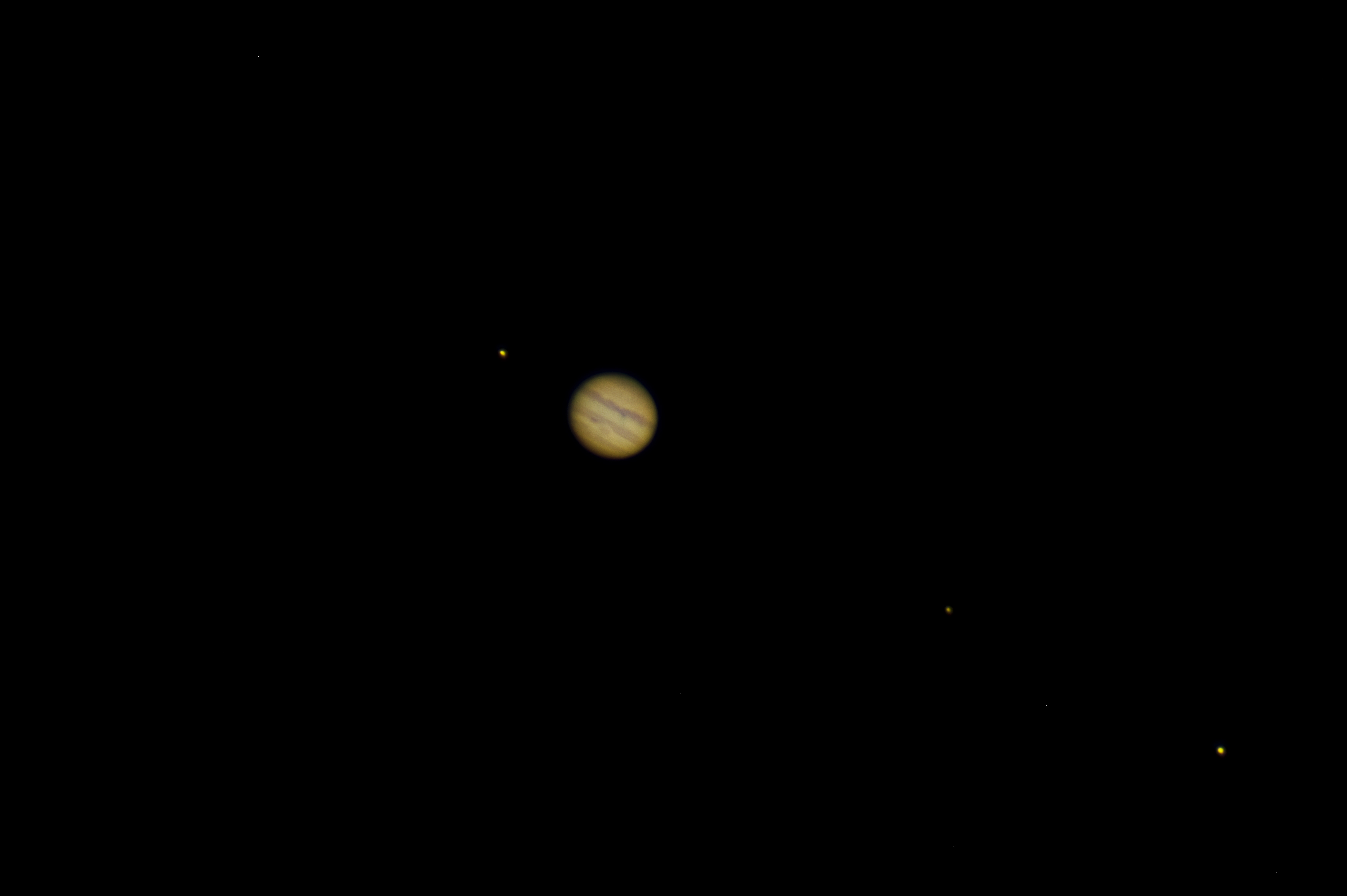
Jupiter photographed on 11 Sept 2009 by Matt Cozza. Image was taken at the
prime focus of the Dearborn Telescope using a Nikon D90 camera.

Jupiter photographed on 11 Sept 2009 by Matt Cozza. Image was taken using a
2x barlow lens at the prime focus of the Dearborn Telescope with a Nikon D90
camera.
Jupiter 04.02.05
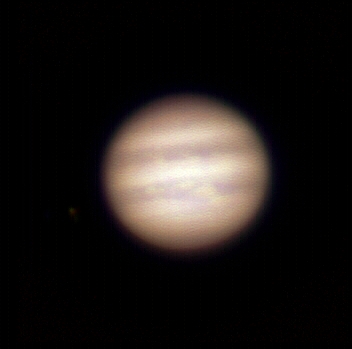
Jupiter, the King of the Planets, boldly shows off its two prominant cloud bands across its
gaseous body. The cloud bands are distinctly colored, somewhat reddish, and result from the
rapid rotation of the planet; they can be likened to "jet streams" on Earth. And there is
Jupiter's famous Red Spot, seen here accompanied by other spots! First noted by Galileo,
the Red Spot is a perpetual hurricaine-like storm, though curiously, it has been recently
seen to diminish in size.
(Thanks to Olivia Tang and Grant Hetherton, who helped take this awesome shot of Jupiter
during their telescope training session!)
(04.02.05, 1x1 bin, 0.01 s RGB, no FR)
Comet Machholz 02.05.05
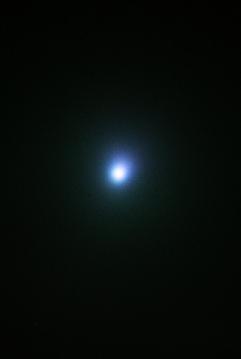
Comet 2004 Q2 Machholz, a brief visitor to the inner solar system, shows off its bright
coma, but its dust and ion tails are much less obvious. (A little imagination might help!)
The comet was discovered by Donald Machholz from the Southern Hemisphere in November 2004.
This image was taken when the comet was about 0.5 AU away, at magnitude 5.
(02.05.05, 1x1 bin, 1.5 min exposure RGB, no focal reducer
Trapezium (in M42, the Orion Nebula) 02.03.05
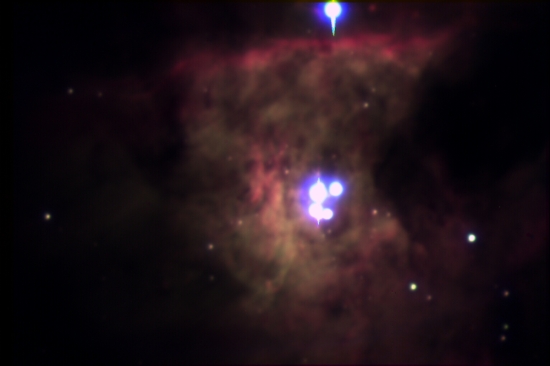
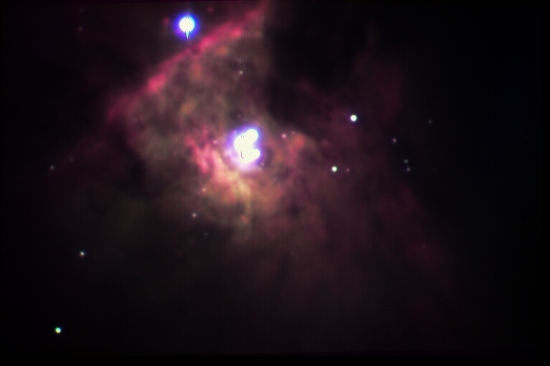
Quadruplets! Born at about the same time and in the same place, these blazingly hot,
massive stars are examples of O/B stars. Together, they are called the "Trapezium" stars
and are labeled 1A, 1B, 1C, and 1D. (The very bright star at the top of the photo is Theta-2
Orionis.) They emit an enormous amount of high-energy radiation that excites the gas around
them, causing their stellar nursery to glow and appear nebulous to us. Because they
burn hydrogen at a tremendously fast rate, they won't live very long ... "only" about 10
million years. (In comparison, a more average star like our Sun lives about 10 billion
years.)
(02.03.05, 1x1 bin, 3 min exposure RG, 1 min B, no focal reducer)
(02.04.05, 1x1 bin, 1.5 min exposure RG, 0.5 min B, with focal reducer)
Saturn 12.26.03
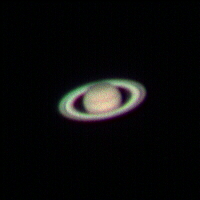
The true Lord of the Rings!
While all the gas giants in our solar system have rings, only Saturn's is directly visible
from Earth. The rings are made up of billions of small icy particles with typical sizes of a
few centimeters, the size of your fist. The darker gap which appears to separate the rings
into two halves is called the Cassini Division, caused by a two-to-one orbital resonance
between the moon Mimas and the particles which once occupied the gap. (Repeated gravitaional
tugs by Mimas on these particles forced them out of that region, and over time, formed a gap.
This and other mechanims have formed many such gaps, Cassini's Division being the largest.)
Notice also horizontal cloud bands crossing Saturn's face, which arise due to Saturn's very
rapid, 10.7 hour rotation rate. As of this writing, we have identified 31 moons of Saturn,
the largest of which is Titan, which also has a nitrogen-rich atmosphere.
Some of Saturn's statistics have a recurring theme of "nine" and "five," making them easy to
remember. For instance, its average distance from the Sun is 9.5 A.U. Compared to Earth,
Saturn's diameter is 9.5 times greater, its mass is 95 times greater, and its gravity is 0.95
as strong. A couple more tidbits: its average orbital speed is about 9.5 km/s, and its
average surface temperature (at cloudtops) is 95 K! And if you'll forgive the extra "2," it
takes 29.5 years for Saturn to orbit once around the Sun.
(12.26.03, Red=RED, Green=GREEN, Blue=BLUE, 2x2 bin, 0.1 sec exposure RG, 0.3 sec B)
Mars 08.27.03
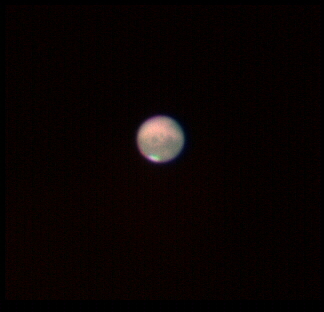
Taken around 1 A.M., Wednesday, August 27, 2003, the day and time when our little spot on
Earth was closest to our red neighbor in some 60,000 years. Mars' reddish hue is due to iron
oxides, that is, "rust." Also prominent is the southern polar ice cap, primarily frozen
carbon dioxide, that is, "dry ice." Terrain features are well resolved ... but where are the
canals???
(08.27.03, H-alpha=LUMINANCE, Deep-sky+Red=RED, Deep-sky+Green=GREEN,
Deep-sky+Blue=BLUE, 2x2 bin, 0.1 sec exposure)
Mars 08.28.03
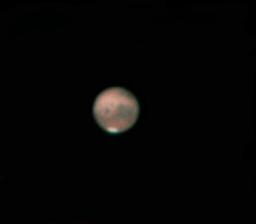
Another mug-shot of Mars taken about 24 Earth hours after the one above. Mars' rotation
period (a Martian day) is about 24.6 of our hours, so we still see the same general features.
Nevertheless, a little net rotation compared to yesterday is apparent in the picture. Thanks
to Hua-bai & Ting-ting Li, and Wei Fang for lending a hand in making this shot.
(08.28.03, H-alpha=LUMINANCE, Deep-sky+Red=RED, Deep-sky+Green=GREEN,
Deep-sky+Blue=BLUE, 2x2 bin, 0.1 sec exposure)
Mars 09.03.03

A slightly different face of the red planet. Taken only a few days after the previous shots, this photo
clearly shows Mars' net rotation compared to ours.
(09.03.03, H-alpha=LUMINANCE, Deep-sky+Red=RED, Deep-sky+Green=GREEN,
Deep-sky+Blue=BLUE, 2x2 bin, 0.1 sec exposure)
Mars 09.10.03
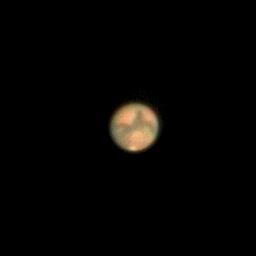
"I'm subliming! I'm subliming!" The southern polar cap is noticably smaller than in previous
photos, as it gradually sublimes during the southern hemisphere's summer.
(09.10.03, H-alpha=LUMINANCE (2s), Deep-sky+Red=RED, Deep-sky+Green=GREEN,
Deep-sky+Blue=BLUE, 2x2 bin, 0.1 sec exposure, with 2xBarlow, frame-resized post
reduction)
Mars 09.10.03
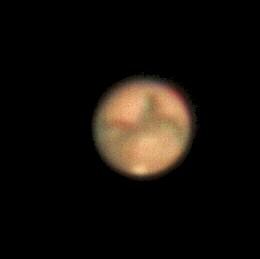
A larger image taken with a 2x Barlow lens. Unfortunately, resolution does not improve much,
due to a combination of instrumentation and atmospheric limitations.
(09.10.03, H-alpha=LUMINANCE (2s), Deep-sky+Red=RED, Deep-sky+Green=GREEN,
Deep-sky+Blue=BLUE, 2x2 bin, 0.1 sec exposure, with 2xBarlow)
M57
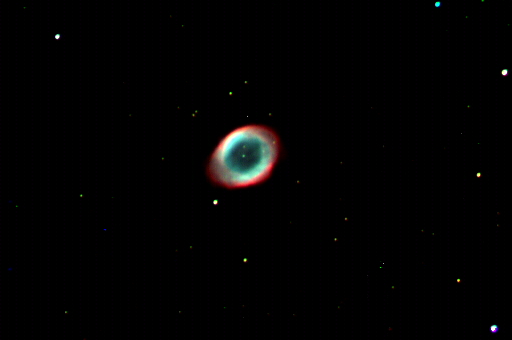
M57, the Ring Nebula in Lyra, is an example of a planetary nebula. Despite its name, planetary nebulae have
nothing to do with planets; they merely resemble them through the telescope. In fact, a planetary nebula is an
expanding shell of hot gas, the outer layers of the star in the center of the ring. The central star is in the
final stages of its life and will eventually become a white dwarf. Indeed, in about 5 billion years, our Sun
will become a planetary nebula and might resemble the Ring Nebula when observed by someone 2,300 light-years
away.
(09.04.03, red=RED(1x10min), green=GREEN(2x5min), blue=BLUE(4x5min), 3x3 bin, f/6.3
reducer)
M27
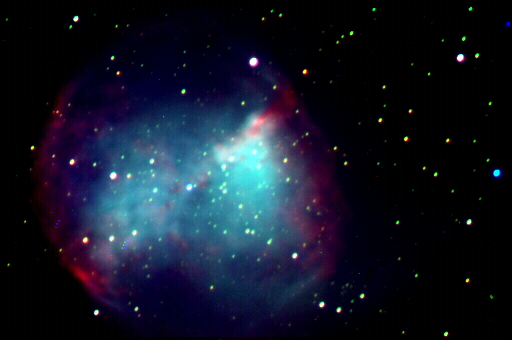
M27, the Dumbbell Nebula in Vulpecula, is another example of a planetary nebula. In fact, it was
the very first one discovered in history by Charles Messier (1764). The central star is a hot blue
star at a temperature of 85,000K, about 15 times hotter than our Sun. Roughly 1000 light years
away, the central star is about 100 times more intrinsically powerful (luminous) than the Sun.
Interestingly, it also has a faint companion which is 100 times less luminous than our Sun. The
highly energetic light excites the atoms in the surrounding shell of gas, and when the atoms relax,
they re-emit mostly blue-green light.
(09.05.03, red=RED(4x5min+1x10min), green=GREEN(4x5min+1x10min), blue=BLUE(6x5min),
3x3 bin, f/6.3 reducer)
M15 09.11.09
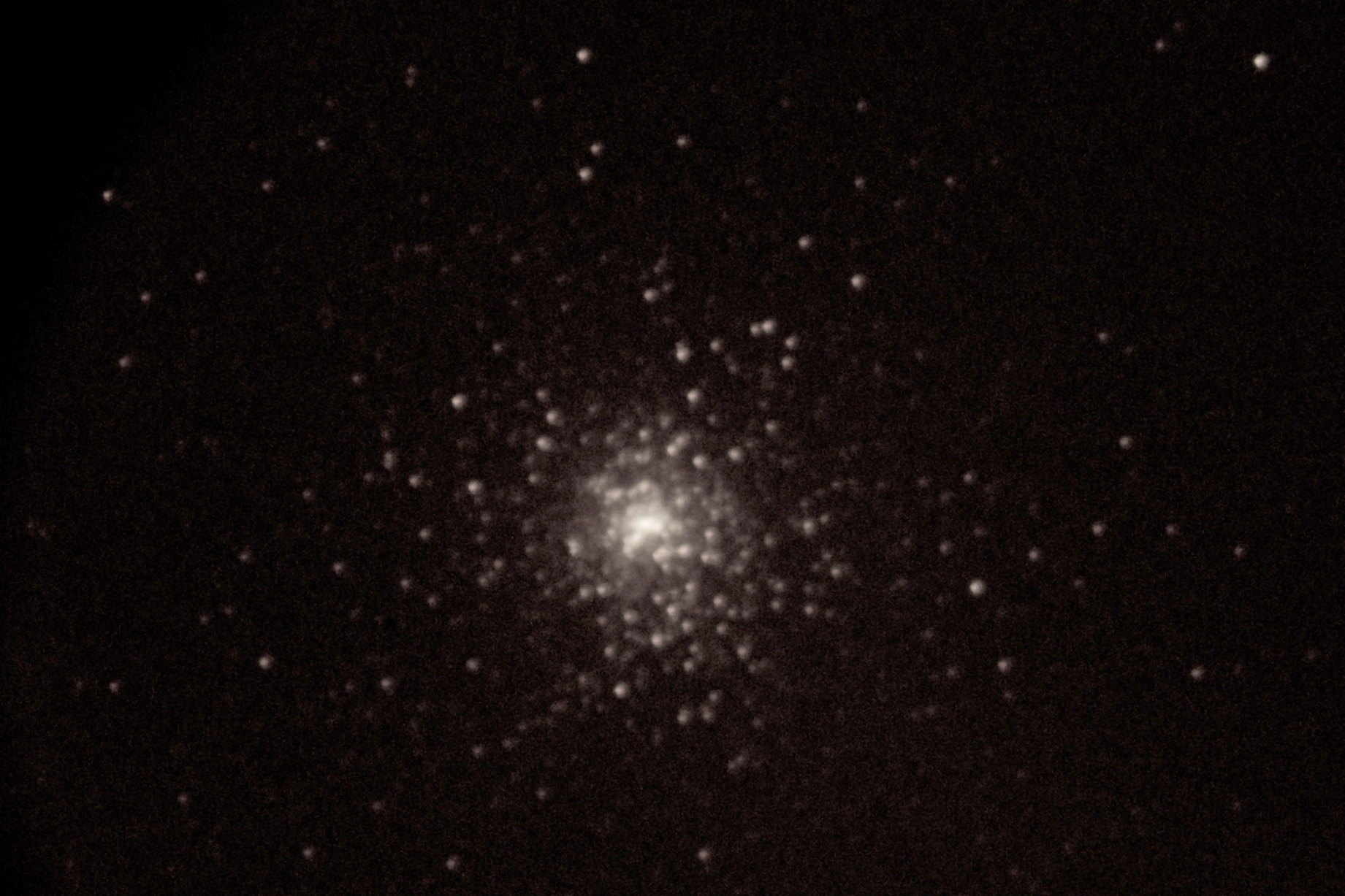
The globular cluster Messier 15 (M15) imaged on 11 Sept 2009 by Matt Cozza.
M15 is located about 33,600 light years away from Earth. It contains
roughly 100,000 stars in a sphere about 200 light years in diameter. Image
taken with a Nikon D90 camera on the Dearborn Telescope.
M15
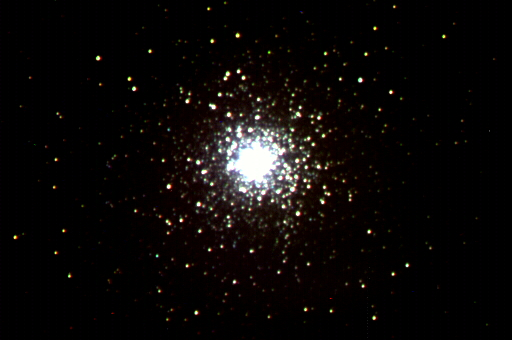
M15 is a globular cluster in our Milky Way Galaxy. It is about 34,000 light years
from us, and measures about 170 light years in diameter. It has perhaps the
greatest star density of all globular clusters in our galaxy, so dense that its
core has collapsed under its own gravity. Thus its core is supermassive, in which
possibly lurks a black hole!
(09.07.03, red=RED(1x5min), green=GREEN(1x5min), blue=BLUE(1x10min), 3x3 bin,
f/6.3 reducer)
M2
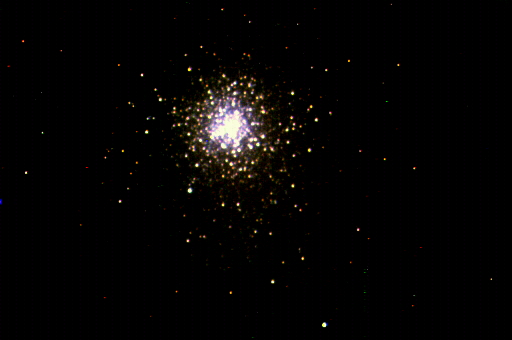
M2 is another globular cluster in our Milky Way Galaxy, 38,000 light years away and
nearly 4 light years in diameter. It has roughly 150,000 stars, mostly red and yellow
giants.
(09.07.03, red=RED(1x2min), green=GREEN(1x2min), blue=BLUE(1x2min), 3x3 bin, f/6.3
reducer)
Uranus
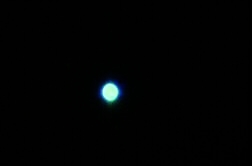
Uranus, 7th planet from the Sun at about 20 A.U., appears greenish-blue because the
methane gas in its atmosphere strongly absorbs the red frequencies from the Sun's light.
Through the telescope, it looks like a small featureless disk, and even close-up photos
taken during Voyager 2's fly-by revealed faint cloud markings only after extensive
computer enhancement. Oddly, its rotational pole is nearly in the plane of its orbit
around the Sun, so that if you lived on one of its poles, the time between sunrise and
sunset would be a half a Uranian year long (42 Earth years), after which, you would enjoy
an equally long night! Incidentally, that day would also be your summer, and the ensuing
night would be your very frigid winter!
(09.17.03, red=RED(20s), green=GREEN(20s), blue=BLUE(40s), 3x3 bin, 2x Barlow)
Neptune & Triton
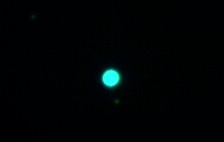
Neptune, 8th planet from the Sun (depending on when you're looking) at about 30 A.U.,
also appears greenish-blue for the same reason as Uranus: a methane-rich atmosphere.
Being further from the Sun than Uranus, it receives about 1/2 the sunlight.
Nevertheless, Voyager 2 photos showed much more dynamic cloud activity and huge storms on
Neptune. Neptunian weather may be powered by heat due to the planet's slow gravitational
contraction. In this photo, the faint object beneath the planet is Triton, Neptune's
largest moon, which is about the size of our own Moon. Oddly, Triton has a retrograde
orbit, meaning it orbits Neptune in the opposite direction as the planet's rotational
direction.
(09.17.03, red=RED(2min), green=GREEN(2min), blue=BLUE(4min), 3x3 bin, 2x
Barlow)
CCD camera = SBIG ST-8 with CFW-8 filter wheel.
Comments or questions? Please contact David:
d-lin@northwestern.edu



















